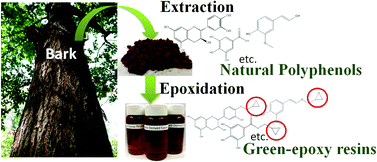Synthesis and characterization of an extractive-based bio-epoxy resin from beetle infested Pinus contorta bark†
Abstract
This work outlines the synthesis and characterization of a green epoxy resin derived from bark extractives. The resins were prepared at various temperatures and catalyst amounts to determine the optima for the yield and epoxy equivalent weight values. FTIR and NMR techniques were used to characterize the chemical structures of extractive-based epoxy (E-epoxy) monomers. Measurement results indicated successful epoxidation of bark extractives after reaction with epichlorohydrin. GPC results revealed that the molecular weights and polydispersities of E-epoxy monomers were lower than those of lignin epoxy (L-epoxy) monomers. The curing kinetic parameters calculated by the Kissinger method and the Model-Free method showed that E-epoxy had a lower curing activation energy value than petroleum-based epoxy (P-epoxy). E-epoxy displayed tensile strength and thermal stability comparable to P-epoxy. The research outcome demonstrated there is promise of using bark extractives to synthesize epoxy resins replacing toxic bisphenol A.


 Please wait while we load your content...
Please wait while we load your content...